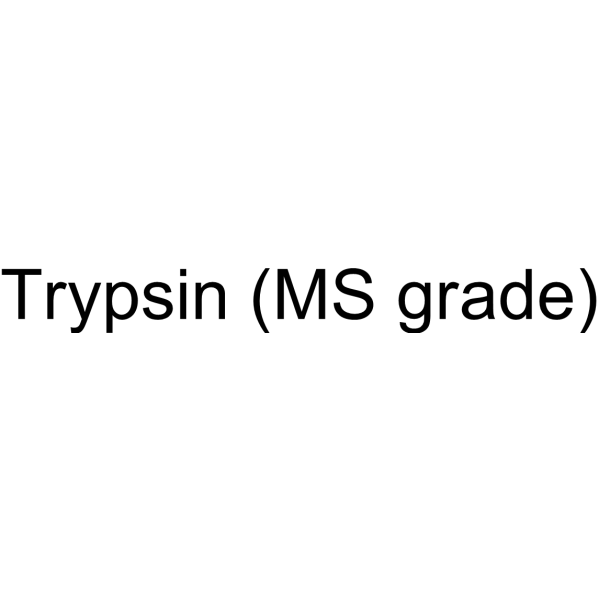Trypsin

Trypsin structure
|
Common Name | Trypsin | ||
|---|---|---|---|---|
| CAS Number | 9002-07-7 | Molecular Weight | 372.1 | |
| Density | N/A | Boiling Point | N/A | |
| Molecular Formula | C6H15O12P3 | Melting Point | 115°C | |
| MSDS | Chinese USA | Flash Point | N/A | |
| Symbol |


GHS07, GHS08 |
Signal Word | Danger | |
Use of TrypsinTrypsin is an enzyme that hydrolyzes proteins at the carboxyl side of the Lysine or Arginine. Trypsin activates PAR2 and PAR4. Trypsin induces cell-to-cell membrane fusion in PDCoV infection by the interaction of S glycoprotein of PDCoV and pAPN. Trypsin also promotes cell proliferation and differentiation. Trypsin can be used in the research of wound healing and neurogenic inflammation[1][2][3][4][6]. |
| Name | Trypsin |
|---|---|
| Synonym | More Synonyms |
| Description | Trypsin is an enzyme that hydrolyzes proteins at the carboxyl side of the Lysine or Arginine. Trypsin activates PAR2 and PAR4. Trypsin induces cell-to-cell membrane fusion in PDCoV infection by the interaction of S glycoprotein of PDCoV and pAPN. Trypsin also promotes cell proliferation and differentiation. Trypsin can be used in the research of wound healing and neurogenic inflammation[1][2][3][4][6]. |
|---|---|
| Related Catalog | |
| Target |
PAR2, PAR4[6] |
| In Vitro | Trypsin (5 μg/mL, 24 or 48 h) promotes porcine deltacoronavirus (PDCoV) replication in LLC-PK cells[2]. Trypsin (10 and 50 ng/mL, 12 h) enhances PDCoV cell-to-cell spread in LLC-PK cells by promoting membrane fusion in LLC-PK cells[2]. Trypsin (0.05%, 3 h) promotes C6 glioma cell proliferation in serum-free and growth factor-free medium[3]. Trypsin (20 -150 ng/mL, 5 days) potentiates PBMC differentiation[4]. Western Blot Analysis[2] Cell Line: LLC-PK cells, ST cells Concentration: 5 μg/mL Incubation Time: 24 or 48 h Result: Promoted PDCoV replication in LLC-PK cells but not ST cells. Immunofluorescence[2] Cell Line: LLC-PK cells, ST cells Concentration: 10 and 50 ng/mL Incubation Time: 12 h Result: Significantly increased cell-to-cell fusion activity during PDCoV infection of LLC-PK cells. |
| In Vivo | Trypsin (100-500 μg per site in 50 μL saline, intradermal injection) induces scratching behaviour in mice[5]. Animal Model: Swiss mice[5] Dosage: 100-500 μg per site, in saline (50 μL) Administration: Intradermal injection Result: Induced pruritus, and was inhibited by trypsin inhibitor. |
| References |
| Melting Point | 115°C |
|---|---|
| Molecular Formula | C6H15O12P3 |
| Molecular Weight | 372.1 |
| Appearance of Characters | lyophilized powder |
| Storage condition | −20°C |
| Stability | Stable. Incompatible with strong oxidizing agents. |
| Water Solubility | Reconstitute in aqueous buffer | Soluble in water (10 mg/ml), phosphate buffers (10 mg/ml), and balanced salt solutions (1 mg/ml). |
| Symbol |


GHS07, GHS08 |
|---|---|
| Signal Word | Danger |
| Hazard Statements | H315-H319-H334-H335 |
| Precautionary Statements | P261-P305 + P351 + P338-P342 + P311 |
| Personal Protective Equipment | dust mask type N95 (US);Eyeshields;Faceshields;Gloves |
| Hazard Codes | Xn,B |
| Risk Phrases | 36/37/38-42-42/43 |
| Safety Phrases | 22-24-26-36/37-45-23 |
| RIDADR | NONH for all modes of transport |
| WGK Germany | 2 |
| RTECS | GC3050000 |
|
Synthetic ion transporters can induce apoptosis by facilitating chloride anion transport into cells.
Nature Chemistry 6(10) , 885-92, (2014) Anion transporters based on small molecules have received attention as therapeutic agents because of their potential to disrupt cellular ion homeostasis. However, a direct correlation between a change... |
|
|
The effect of amniotic membrane de-epithelialization method on its biological properties and ability to promote limbal epithelial cell culture.
Invest. Ophthalmol. Vis. Sci. 54(4) , 3072-81, (2013) We characterized the de-epithelialized human amniotic membrane (HAM), and compared cell attachment and proliferation efficiencies.HAM was de-epithelialized by 20% ethanol (AHAM), 1.2 U/mL Dispase (DHA... |
|
|
Histo-blood group antigens act as attachment factors of rabbit hemorrhagic disease virus infection in a virus strain-dependent manner.
PLoS Pathog. 7(8) , e1002188, (2011) Rabbit Hemorrhagic disease virus (RHDV), a calicivirus of the Lagovirus genus, and responsible for rabbit hemorrhagic disease (RHD), kills rabbits between 48 to 72 hours post infection with mortality ... |
| MFCD00082094 |
| EINECS 232-650-8 |

